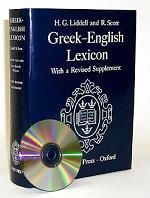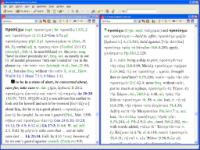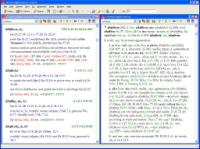 Liddell
and Scott Greek-English Lexicon
Liddell
and Scott Greek-English Lexicon
Ninth Edition, with Revised Supplement 1996
H. G. Liddell and R. Scott
Revised and augmented throughout by Sir Henry Stuart Jones, with the
assistance of Roderick McKenzie, and with the cooperation of many scholars.
Supplement edited by P. G. W. Glare.
- 2,438 pages
- 127,000+ articles
- 26,000+ updated articles in the supplement, now integrated into the
body
Imprint: Clarendon Press - Oxford
The world's most authoritative dictionary of ancient Greek
Indispensable for biblical and classical studies alike, the world's most
comprehensive and authoritative dictionary of ancient Greek is now available
with the Revised Supplement integrated into the body of the text for the
first time ever. The publication of the Revised Supplement in 1996 marked a
major event in classical scholarship and was the culmination of 13 years'
painstaking work overseen by a committee appointed by the British Academy,
involving the cooperation of many experts from around the world.
The Main Dictionary: Liddell and Scott's Greek-English Lexicon (9th edition
1940), is the central reference work for all scholars of ancient Greek
authors and texts discovered up to 1940, from the 11th century BC to the
Byzantine Period. The early Greek of authors such as Homer and Hesiod,
Classical Greek, and the Greek Old and New Testaments are included. Each
entry lists not only the definition of a word, but also its irregular
inflections, and quotations from a full range of authors and sources to
demonstrate usage.
The Logos Bible Software Series X electronic edition is the most
useful version of Liddell and Scott (LSJ) ever assembled (see Preface below).
It is the only edition in which the hundreds of pages and 26,000+ articles
of 'Supplement' material have been integrated into the text of the main
lexicon, allowing the user to instantly access the 1996 revisions and
additions without flipping pages. And like all Logos reference works the
electronic edition links to all the other reference books in Logos Bible
Software Series X for instant lookup of related texts and Bible references.
Note: For Classicists who use Antiquarium 2 by Quadrivium Software,
the Logos edition of LSJ can be accessed from within Antiquarium via a
single keystroke.
Praise for the Electronic
Edition
...the digital LSJ is a real gain and a must for classicists. (more...)
—Bryn Mawr Classical
Review, Willeon Slenders, Radboud University Nijmegen
All in all, it is a pretty slick way to access that magnificent reference
work. (more...)
—Classical Review,
Rob Latousek (Centaur Systems), Random Access columnist
In the electronic Liddell and Scott, the Revised Supplement is seamlessly
woven into the dictionary's lemmata and is available nowhere else
electronically. The presentation of the dictionary's entries in the
electronic Liddell and Scott is much easier to read, with generous white
space separating subsections that in the print Liddell and Scott cause
blurred vision even in the youngest. In addition, while not correcting all
of the erroneously or confusedly labeled sections and subsections of a
lemma's definition...the electronic edition's layout makes it easy to see an
ordered and logical presentation of the definition. (more...)
—Bryn Mawr Classical
Review, Gerald Verbrugghe, Rutgers University, Camden
Preface to the Electronic
Edition of A Greek-English Lexicon
This Logos Bible Software edition of A Greek-English Lexicon (hereafter “LSJ”)
has a number of distinctives, including:
- Integration of the revised (1996) supplement in the main body text.
- Formatting enhancements that make the text more readable.
- Inclusion of various fields for searching enhancement.
Supplement Integration
Oxford University Press achieved a monumental task in lexicography with its
comprehensive update and 1996 release of the supplement to the ninth edition
of LSJ. Out of the more than 125,000 articles of LSJ, the supplement
specifies over 25,000 updates—one out of every five articles.
In preparing an electronic edition of LSJ, the next natural step was taken:
full integration of the supplement content into the main body text of LSJ.
Lexicon users no longer need to examine two different locations in the
lexicon when studying a word that is included in the supplement. The content
has been seamlessly integrated.
Articles that have been updated in accordance with supplement guidelines are
denoted by the presence of a circled star  preceding the article headword.
This is reminiscent of the print edition’s symbol denoting updated articles
and as such should be familiar to users of the printed text.
preceding the article headword.
This is reminiscent of the print edition’s symbol denoting updated articles
and as such should be familiar to users of the printed text.
Formatting Enhancements
The text of the print edition of LSJ is typographically dense. The font size
is small, and definition senses are listed consecutively with no vertical
breaks. These are all justifiable formatting decisions for a print edition
of a lexicon such as LSJ as they reduce production cost through keeping page
count down, allowing more information to be packed into the lexicon.
In an electronic edition, however, the text can have “room to breathe.”
Rather than fully emulate the printed two-column format, decisions were made
early on to use vertical and horizontal white space to make the articles
themselves more readable. Indentation, therefore, shows the overall
structure of an article. The outline-style formatting of many of the
articles is now visible and helpful in determining the scope of a given word.
This has the additional benefit of making the text easier to skim when
searching for a particular sense of a word.
The print edition of LSJ also conserves space in its grouping of article
headwords by prefix where words with similar prefixes are able to be
logically grouped. The front matter states, “The Hyphen has for the most
part been used without regard to etymology, to represent that group of
letters which is common to two or more consecutive words.” The print edition,
therefore, contains dashes in headwords to denote the prefix for a given
group, then sub-entries within the group are suffixes that assume the
previous prefix.
This as well has been enhanced in this electronic edition. Each article
begins a new line, and each headword is complete, with prefix and suffix
joined forming one word. This, of course, makes it easier to locate a given
headword in the text.
Search Enhancements
The print edition of LSJ employs some typographical practices that allow
certain assumptions to be made in the electronic edition.
Firstly, italicized text, with the exception of abbreviations, indicates a
definition gloss. In several instances, particular instances of words in
classical literature are cited and glossed. Therefore all italic text has
been indexed within a gloss field. This field is searchable, so one may
locate instances of a given word (e.g., boat) when it is supplied as a gloss.
Secondly, text within [square brackets] indicates a prosodial remark.
Therefore all text within square brackets has been indexed within a prosody
field.
Thirdly, text within (parentheses) indicates an etymological remark.
Therefore all text within parentheses has been indexed within an etymology
field.
Fourthly, Greek headwords have been indexed within the lemma field. Other
Greek words appearing in bold text have been included as article-level
topics.
For more information about these fields, choose Help | About this Resource
from the main application menu. For information on searching using fields,
search the Libronix Digital Library System Help Manual for (include the
quotes) “Field Searching.”
Final Note
Several skilled hands and minds have been associated with the preparation,
improvement, development, and publication of this great lexicon over the
past 160 years. It is a privilege to now be associated with this highly
respected body of work.
The Value of A Greek-English
Lexicon (LSJ) for Biblical Studies
A Greek-English Lexicon, also known as Liddell & Scott or as LSJ, is
perhaps the most well respected classical Greek lexicon available today.
Though LSJ deals primarily with classical Greek, it has several applications
to Biblical study:
- Provides information on words in LXX, which is typically lacking in
NT-oriented Greek lexicons
- Provides information on words in NT as many of these words were
frequently used in secular literature
- Provides information on words infrequently used in the LXX or NT
- Provides information on classical usage of words, which may be
helpful in etymological studies
Using LSJ with New Testament Studies
The example of προσέχω
in 1 Tim 1:4 is a decent example of the use of LSJ with New Testament
Studies. It also serves as an example for learning more about classical
usage of Greek words.
4 nor to devote themselves to
myths and endless genealogies, which promote speculations rather than
the stewardship from God that is by faith. 1 Timothy 1:4 (ESV)
 The
word προσέχω in
its various inflected forms, occurs 24 times in the New Testament. BDAG
glosses the sense of the word as used in 1 Tim 1:4 as pay attention to,
give heed to, or follow. The ESV above translates
προσέχω as to
devote. BDAG notes that when used with a dative, the idea of pay
attention to is most likely intended.
The
word προσέχω in
its various inflected forms, occurs 24 times in the New Testament. BDAG
glosses the sense of the word as used in 1 Tim 1:4 as pay attention to,
give heed to, or follow. The ESV above translates
προσέχω as to
devote. BDAG notes that when used with a dative, the idea of pay
attention to is most likely intended.
LSJ discusses a number of senses of the word. For instance, as is visible in
the screen capture to the right, several nautical senses are discussed. In
sense I.4.b, LSJ notes that the word, when used with a dative noun (and "myths
and endless genealogies" is in the dative case) can be glossed as "devote
oneself to a thing" and offers several classical citations that can be
examined to confirm this reading.
One sense of the word that isn't presented in the portion of the LSJ article
in the screen capture is an interesting citation from Theophrastus, who uses
the word passively of gum (yes, gum) sticking to something.
While the primary definition offered in this instance in BDAG is, of course,
correct, LSJ proves valuable to examine simply to get a better understanding
of the word προσέχω
and the nuances it held in secular Greek society.
Using LSJ with Septuagint Studies
The example of άλήθεια
(inflected form άλήθειαν)
in Leviticus 8:8 is insightful. The word
άλήθεια occurs frequently in the LXX and
is typically translated truth. However, note this verse in English:
8 And he placed the
breastpiece on him, and in the breastpiece he put the Urim and the
Thummim. Leviticus 8:8 (ESV)
 The
word άλήθεια is
here translated as Thummim. But why is that, as the seemingly proper
translation should be truth? A Greek English Lexicon of the
Septuagint (hereafter LEH) glosses this particular reference with "symbol
of the truth (of the Thummim)". So the translation as Thummim is
justified, but the justification (apart from simple fiat) is not forthcoming.
The
word άλήθεια is
here translated as Thummim. But why is that, as the seemingly proper
translation should be truth? A Greek English Lexicon of the
Septuagint (hereafter LEH) glosses this particular reference with "symbol
of the truth (of the Thummim)". So the translation as Thummim is
justified, but the justification (apart from simple fiat) is not forthcoming.
Enter LSJ. The LSJ definition lists a number of senses. The fourth major
sense (the entry in LSJ is so long that the fourth sense does not show in
the screen capture on the right) reports:
IV. symbol of truth, jewel worn by Egyptian high-priest,
D.S.1.48, 75, Ael.VH14.34: of the Thummim, LXX.Le.8.8
Note the two citations. D.S. refers to a first-century BC author (Diodorus
Seculus) and Ael refers to a second to third century AD author Aelianus. In
these references LSJ cites two sources where
άλήθεια was used to refer to a jewel
worn by the Egyptian high priest as a symbol of truth. A usage that
looked unique in the LXX found parallel usage in non-biblical Hellenistic
literature, giving information about a word's usage that would be beyond the
scope of any NT lexicon.
Another Septuagint Example
The example of διαφορέω
in Jeremiah 37:16 (Jer 30:16 ESV) is also helpful. The word
διαφορέω apparently
only occurs here in the Septuagint, and it does not occur in the New
Testament. Here is the verse in English:
16 Therefore all who devour
you shall be devoured, and all your foes, every one of them, shall go
into captivity; those who plunder you shall be plundered, and all who
prey on you I will make a prey. Jeremiah 30:16 (ESV)
 The
word plunder represents the word
διαφορέω. Well, plunder is really
a translation of the Hebrew as the ESV uses the Hebrew Old Testament as its
basis, but this is close enough for purposes of this example. LEH glosses
διαφορέω as to
tear to pieces. However, the LEH definition ends there, and nothing else
is mentioned.
The
word plunder represents the word
διαφορέω. Well, plunder is really
a translation of the Hebrew as the ESV uses the Hebrew Old Testament as its
basis, but this is close enough for purposes of this example. LEH glosses
διαφορέω as to
tear to pieces. However, the LEH definition ends there, and nothing else
is mentioned.
The LSJ definition, however, is much more extensive. It lists five major
senses of the word and provides a number of examples from classical
literature. After all, if the Ancient Greeks knew how to do anything, it was
war — just think of the battles between the Athenians and the Spartans. LSJ
even notes some usages of
διαφορέω in medical writers, providing a well-rounded
glimpse of how classical Greek writers used this term.
Once again, the primary sense of
διαφορέω as defined by LEH does provide the basic
information needed, but the expanded information offered by LSJ on this word
is helpful to gain a fuller understanding of the term.
Using LSJ with Infrequently Used New Testament or
Septuagint Words
One problem students of Greek encounter is the problem of words infrequently
used in the New Testament and Septuagint. The use of
λουτρόν in Titus 3:5 offers an
interesting example.
5 he saved us, not because of
works done by us in righteousness, but according to his own mercy, by
the washing of regeneration and renewal of the Holy Spirit, Titus 3:5 (ESV)
 The
word λουτρόν is
translated as washing in the ESV. It occurs twice in the New
Testament; here and also in Eph. 5:26. Again, the BDAG definition is
adequate and conveys the meaning of the word in the New Testament. However,
when examining LSJ, one sees that LSJ uses the majority of its definition
listing citations to the actual, physical sense of bathing, not the
ceremonial or figurative sense. So, while the sparse New Testament usages
are concentrated on the idea of a figurative cleansing, the word
λουτρόν could also
perhaps carry the sense of actually bathing. While LSJ does not alter the
primary understanding of the NT sense of the word (it actually confirms it
in one of its senses) one does arrive at a greater idea of the range of
meaning of a word.
The
word λουτρόν is
translated as washing in the ESV. It occurs twice in the New
Testament; here and also in Eph. 5:26. Again, the BDAG definition is
adequate and conveys the meaning of the word in the New Testament. However,
when examining LSJ, one sees that LSJ uses the majority of its definition
listing citations to the actual, physical sense of bathing, not the
ceremonial or figurative sense. So, while the sparse New Testament usages
are concentrated on the idea of a figurative cleansing, the word
λουτρόν could also
perhaps carry the sense of actually bathing. While LSJ does not alter the
primary understanding of the NT sense of the word (it actually confirms it
in one of its senses) one does arrive at a greater idea of the range of
meaning of a word.
So once again LSJ has helped in gaining a clearer picture of what
λουτρόν might have
meant in its normal, everyday context. While the context of Biblical study
is primarily a religious one, people from the New Testament era lived in
both spheres — the secular and the religious — much as we do today.
Understandably, even today our concept of washing or bathing
in the context of Titus 3:5 is enhanced simply because we have an idea of
what it means to wash ourselves physically. The same is true for all
languages. LSJ simply helps in providing a larger context of Greek usage,
which helps enhance understanding of these terms as the Bible is studied and
interpreted.
| Стоимость CD-ROM: 15 у.е. |



